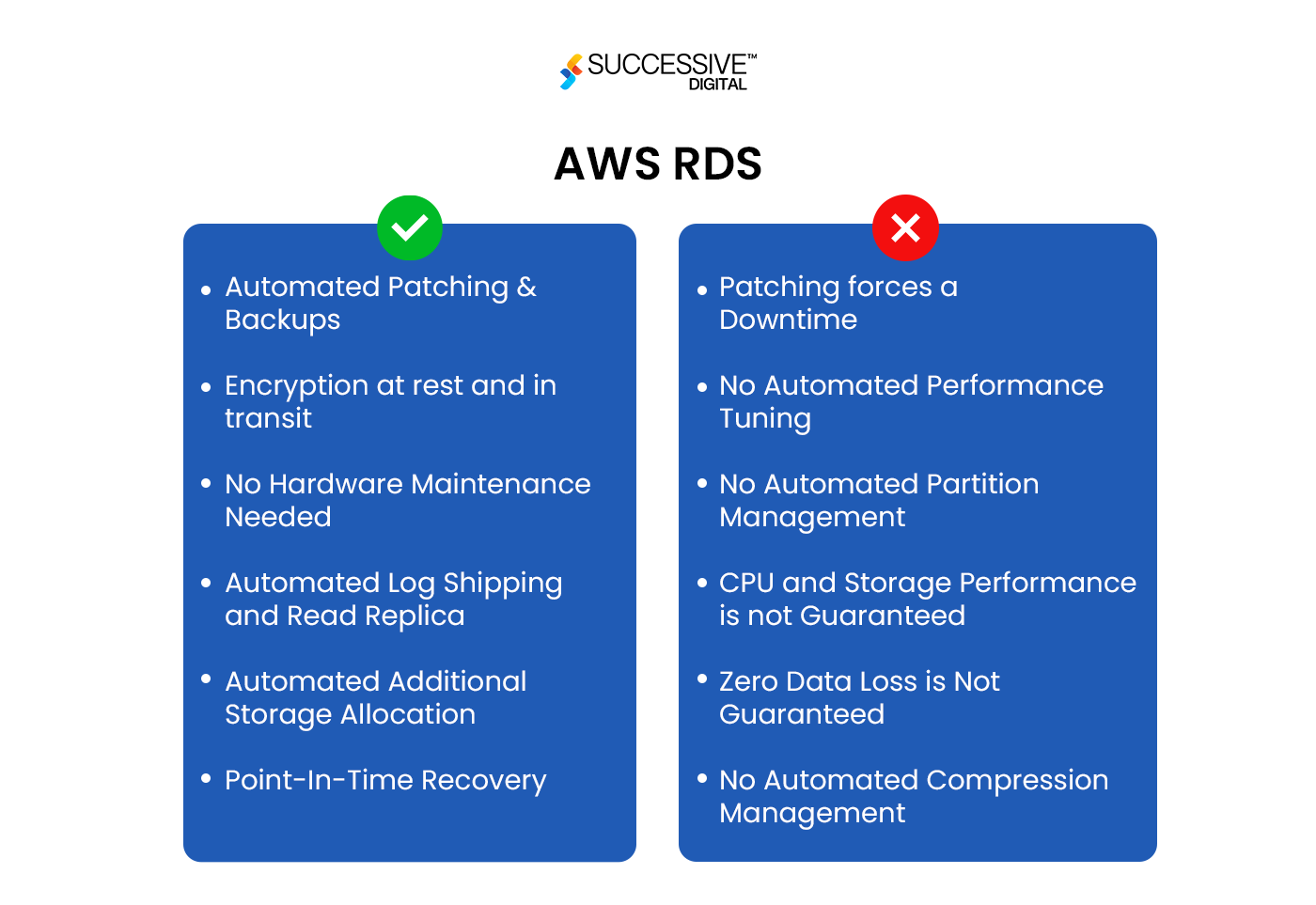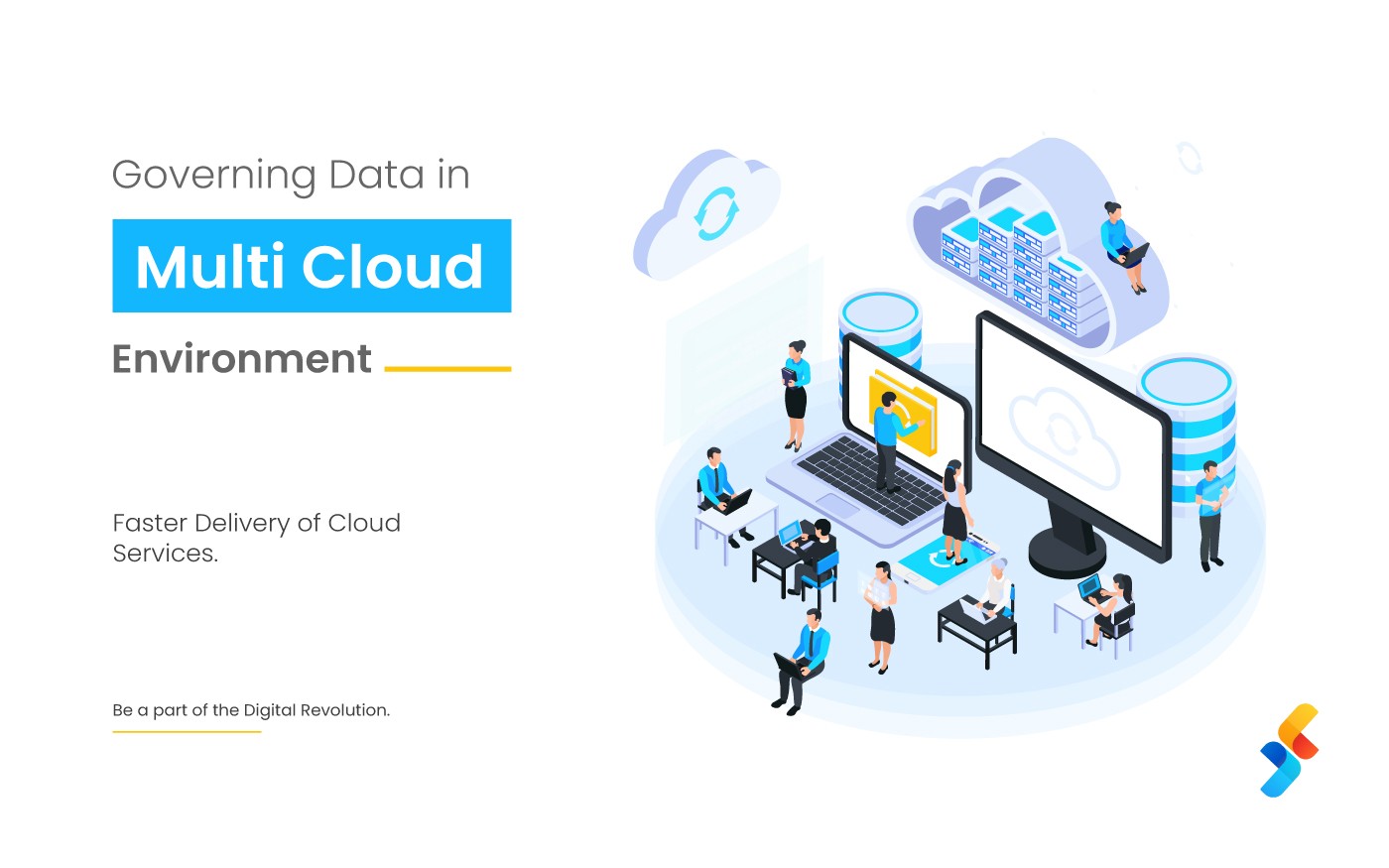Are you struggling to find the best AWS database for your project? Here’s the solution. This blog post will address all your queries regarding AWS RDS and Aurora, including their benefits, applications, and distinctions between them. If you read this article to the end, you will be better able to select the suitable database for your application development needs.
In the current environment, businesses rely heavily on data as a vital resource to transform their operations. Nevertheless, they need help as the data volume grows. We can solve this problem with cloud databases using several forms of replication, distributed architecture, and scalability.
The two most well-known cloud databases are AWS Aurora and AWS RDS. In this post, we will compare AWS RDS vs AWS Aurora to help you select the best one for your needs. So, let’s get started right away.
AWS RDS: An Overview
Amazon Relational Database Service (Amazon RDS) is a web service that simplifies the setup, operation, and scaling of relational databases on the AWS Cloud. It offers cost-effective, scalable capacity for an industry-standard relational database and handles everyday database administration operations.
Amazon RDS is an easy-to-manage relational database solution emphasizing total cost of ownership. It is easy to assemble, run, and expand to meet demand. Undifferentiated database management tasks, including provisioning, configuration, backups, and patching, are automated by Amazon RDS. With 8 engines and 2 deployment methods, Amazon RDS allows users to configure databases to address their needs in minutes. Customers can pick from various pricing choices to effectively manage costs and enhance performance with features including AWS Graviton3-based instances, Optimized Writes and Reads, and Multi-AZ with two readable standbys. Now, let’s dive deep into the pros and cons of AWS RDS to understand it better.
Pros
- Automated Patching & Backups
AWS RDS automates patching and backups, lowering developers’ workload while guaranteeing that databases are kept up to date and backed up for data protection and integrity.
- Encryption at rest and in transit
RDS uses robust encryption technologies to protect data at rest and in transit, ensuring compliance with security standards and safeguarding sensitive information from unauthorized access.
- No Hardware Maintenance Needed
With RDS, businesses don’t have to worry about hardware upkeep because AWS handles the underlying infrastructure, allowing them to focus on their core operations without worrying about managing actual servers.
- Automated Log Shipping and Read Replica
RDS streamlines log shipping and facilitates read replica creation for increased scalability and performance. This allows enterprises to offload read-heavy tasks and improve application responsiveness.
- Automated Additional Storage Allocation
RDS dynamically expands storage depending on consumption patterns, ensuring that databases have the resources to handle growing data volumes without requiring manual intervention. This optimizes cost-efficiency and scalability.
- Point-In-Time Recovery
RDS provides point-in-time recovery capabilities, allowing enterprises to restore databases to specified points and reducing data loss due to unintentional deletions or errors.

Cons
- Patching forces a Downtime
While patching is automatic, implementing patches may result in database downtime, reduced application availability, and potentially affected company operations during maintenance windows.
- No Automated Performance Tuning
AWS RDS lacks automated performance tuning options, requiring user intervention to maximize database performance, which may necessitate expertise and time investment from IT teams.
- No Automated Partition Management
RDS does not include automated partition management options. Thus, administrators must manually maintain partitions for optimal database performance and resource utilization, which may lead to inefficiencies and additional administration overhead.
- CPU and Storage Performance is not Guaranteed
CPU and storage performance in RDS instances cannot be guaranteed because it is determined by various factors, such as instance type, workload characteristics, and resource allocation, all of which can impact application performance and responsiveness.
- Zero Data Loss is Not Guaranteed
Despite its backup and recovery features, AWS RDS can not ensure zero data loss, as data loss might occur during backup intervals or due to other unanticipated events, emphasizing the need for additional data protection methods.
- No Automated Compression Management
RDS does not support automated compression management, necessitating manual configuration and control of compression settings to optimize storage consumption and performance. This complicates database administration responsibilities.
Aurora: An Overview
Amazon Aurora (Aurora) is a fully managed relational database engine that supports MySQL and PostgreSQL. We’ve already seen how MySQL and PostgreSQL combine the speed and dependability of high-end commercial databases with the simplicity and cost-effectiveness of open-source databases. Aurora supports the same code, tools, and applications you now use with your MySQL and PostgreSQL databases. Additionally, it can give up to 5X throughput of MySQL and 3X the throughput of PostgreSQL without requiring changes to the existing applications.
Amazon Aurora offers exceptionally high performance and availability on a global scale and completes MySQL and PostgreSQL compatibility at a fraction of the cost of commercial databases. It has comprehensive compliance standards and robust security capabilities. Aurora provides storage resilience by ensuring data durability across three AZs. Aurora offers a 99.99% availability rate, and users can obtain local read performance via Global Database when deployed across AWS Regions. Aurora can scale to hundreds of thousands of transactions per second using serverless technology. Its zero-ETL interface with Amazon Redshift provides near-real-time analytics on transaction data. To further understand Aurora, let’s have a look at the pros and cons of it.
Pros
- Fault Tolerance
AWS Aurora includes a built-in fault-tolerant architecture with data replication across several Availability Zones, delivering high availability and data durability while lowering the risk of data loss and downtime.
- High Performance
Aurora outperforms traditional databases regarding throughput and latency because of its enhanced storage and processing capabilities.
- High Availability
Aurora’s automatic failover and replication ensure excellent database availability, reducing downtime and providing uninterrupted access to data for essential business operations.
- Easy to Migrate
Aurora simplifies the migration process by integrating with existing MySQL and PostgreSQL databases, reducing downtime and work necessary to convert to the Aurora platform and ensuring smooth enterprise migration.
- Highly Scalable
Aurora provides seamless scalability, allowing enterprises to flexibly alter computing and storage resources to meet changing workload demands while maintaining optimal performance and cost-efficiency as data volumes expand.
- Auto Scaling Capabilities
Aurora supports auto-scaling, which automatically modifies compute and storage capacity based on workload patterns. This optimizes performance and resource consumption without the need for manual intervention.

Cons
- Limited Resources for Small Instances
Aurora deploys resources or applications on different instant types including smaller instances having constrained computational resources, which could affect scalability and performance for applications.
- Additional Data Transfer Costs
Businesses utilizing Aurora may incur additional charges for data transport between Availability Zones or regions, particularly in cases involving data replication and failover, potentially raising overall operational expenses.
- High Load Apps Result in High Cost
High-load applications on Aurora may incur additional expenditures due to increased resource use, potentially resulting to higher operational expenses for organizations with heavy workloads.
- Data Sovereignty
Aurora’s data storage and processing may be subject to AWS data residency restrictions, impacting data sovereignty and compliance obligations for enterprises operating in regulated industries or geographic zones.
- Complex Management
Aurora databases necessitate expertise and resources because of their complicated architecture and innovative functionality, complicating database management operations and increasing enterprise operational costs.
AWS RDS Vs. Aurora
Let’s have a detailed comparison of both databases to help you understand which one would better understand your business requirements.
-
Amazon Aurora vs. RDS: Architecture
Amazon Aurora’s cloud-native architecture separates computing and storage. Aurora saves data to a shared cluster volume. This cluster is split between six storage nodes and three AWS Availability Zones. This provides Multi-AZ resiliency, and Aurora automatically expands or contracts your volume to meet your data storage requirements up to 128TiB.
In comparison, RDS provides up to 64 TiB for the MySQL, MariaDB, Oracle, and PostgreSQL engines and 16 TiB for the SQL Server engine. Furthermore, you do not need to offer storage, saving you time and effort. Pricing also adjusts based on your data. Aurora follows the “pay for what you use” paradigm of Amazon S3. The compute nodes handle queries and communicate with the common cluster volume. You do have the same primary and replica split. However, replication happens exclusively within the storage nodes.
This means that no synchronous replication occurs between compute nodes. Nodes do not have any persistent state either. In RDS, each node handles both computing and storage. And, unlike Aurora, which is developed from the ground up for the cloud, RDS is more similar to a typical database solution that operates in the cloud.
However, Amazon RDS streamlines databases’ creation, installation, and administration directly on Amazon EC2 instances. With just a few clicks, you’ll have a database ready to store your data on the AWS cloud. That design allows you to operate with up to five alternative database engines: MySQL, PostgreSQL, MariaDB, Oracle, and Microsoft SQL Server. You can also use RDS on-premises, such as Amazon RDS on AWS OutPosts and the Database Migration Service, to migrate your data to the AWS Cloud. In comparison, Aurora only supports MySQL and PostgreSQL.
-
Amazon RDS vs. Aurora: Performance and scalability
Amazon RDS is a high-performance database that can scale up to 32 vCPUs and 244 GiBs of memory. Discover more about AWS well architected review here. Aurora offers limitless scalability, extending in 10 GB increments to ensure peak performance. RDS does not divide computing and storage as Aurora does. New RDS replicas must copy all current data before they can service requests. Furthermore, new replicas generate more replica traffic, which can reduce your throughput rate. As a result, RDS restricts you to 5 replicas to keep replication under control.
However, the service includes SSD-backed storage and dedicated hardware to improve performance. Additionally, RDS allows you to select between Provisioned IOPS and General-Purpose storage to maintain consistent IOPS performance. Furthermore, RDS on Amazon EC2 lets you increase CPU, memory, IOPS, and storage separately. When you buy RDS on AWS OutPosts for on-premises use, these services will work together rather than separately.
RDS provides additional DB instance classes than Aurora, including Standard, Memory-Optimized, and Burstable, whereas Aurora only supports Memory-Optimized and Burstable.
However, Amazon Aurora Serverless allows you to automatically raise or decrease the capacity of your computing nodes based on your data processing requirements. Amazon Aurora’s independent computation and storage architecture, combined with support for on-demand scaling (a serverless feature), allows Aurora to be faster, more durable, and recover faster from failure than conventional Amazon RDS.
-
Amazon Aurora vs. RDS: Data backups and replication
Aurora can support up to 15 replicas, but RDS allows only 5. All Aurora clones and the primary instance share the same volume, allowing millisecond replications. This is because the replicas automatically access the data or updates held on the shared volume instead of RDS MySQL, which requires it to be replicated to each instance before any can serve requests.
Failovers are automatic here, and Aurora prevents data loss. You can also choose your replica failover priority. In addition, Amazon Aurora enables Multi-AZ backups, which are faster than RDS.
RDS on Amazon EC2 allows you to run a database instance across many AZs (Multi-AZ resiliency) in the same AWS Region. The service simultaneously replicates your primary database’s data to all standby EC2 instances in all Availability Zones. In a Multi-AZ system, secondary databases can handle read traffic.
However, configuring failover in RDS is a laborious operation. Whenever a compute node fails, RDS automatically replaces it.
-
Amazon RDS vs. Aurora: Availability and durability
RDS and Aurora’s automated backups provide point-in-time recovery of database instances.
RDS allows you to create backups of your instances, which are saved in Amazon S3. These are user-initiated backups. RDS stores snapshots until you expressly delete them.
On Aurora, the Point-in-Time function allows you to restore your data anytime during the retention period (35 days). You can also recover data from the last five minutes. Read this blog about cloud cost analysis to further understand cloud computing costs.
Furthermore, you can revert to your original database state without restoring data from a backup. Aurora analyzes your drives and data blocks for mistakes and instantly replaces them.
-
Amazon Aurora vs. RDS: Security, authentication, and encryption
Security on Amazon Aurora and RDS are similar to some extent. Both give you control over who may access your database on a DB instance. The approach you use for managing access to your RDS or Aurora database is determined by the task at hand. You can still maintain network access control by running your database instance in an Amazon VPC.
You can also utilize AWS Identity and Access Management policies to grant permissions (IAM database authentication). The IAM policies define who can administer your RDS or Aurora resources.
Security groups allow you to control which EC2 instances or IP addresses can connect to your database on a DB instance. Any effort to get access that is not approved by the policies of the linked security group is strictly prohibited.
Transport Layer Security (TLS) or Secure Socket Layer (SSL) connections are also supported for database instances running MySQL, PostgreSQL, MariaDB, Oracle, and Microsoft SQL Server.
Amazon Aurora also supports Kerberos authentication, so you can authenticate users who are connecting to your Aurora MySQL DB and PostgreSQL clusters.
Amazon RDS enhances data security by encrypting database instances and snapshots at rest.
-
Amazon RDS vs. Aurora: Pricing
Amazon’s RDS pricing depends on consumption. However, RDS billing is determined by several criteria, including the database engine, DB instance type, DB region, purchasing choice (Reserved or On-Demand), outbound data transfers, deployment style, and whether you want more storage.
You can use the RDS price parameters to estimate your costs in advance. This is not always achievable with Aurora, particularly in the serverless mode.
Amazon Aurora pricing is based on pay-as-you-go, Reserved Instance, and On-Demand models. Amazon Aurora invoicing is based on cluster setup and includes charges for database instances, I/O, and storage. The invoice will also include any optional features you choose to activate.
When to choose AWS RDS?
- AWS Relational Database Service is the best option if your organization needs support for various databases, including MySQL, PostgreSQL, Oracle, SQL Server, MariaDB, etc.
- You should utilize AWS RDS when you wish to conduct vertical scaling for database adjustments and the workload varies or changes regarding translation volumes.
- AWS RDS might be preferable if you use parameter groups to customize the database parameter settings.
When to choose Aurora?
- You want to reduce the replication lag and data latency to enable real-time functionality in the apps.
- The application needs more scalability with a Aurora database. As such, you may utilize it to scale your database up or down dynamically based on demand.
- The main goal of your application is to be compatible with the PostgreSQL and MySQL database engines.
Amazon RDS and Aurora: How do they work together?
The following data shows how Amazon Aurora related to the conventional PostgreSQL and MySQL engines offered by Amazon RDS:
When configuring new database servers with Amazon RDS, you can use either Aurora PostgreSQL or Aurora MySQL as the DB engine.
Aurora leverages the well-known management and administrative tools of Amazon Relational Database Service (Amazon RDS). Aurora manages standard database operations like provisioning, patching, backup, recovery, failure detection, and repair using the Amazon RDS AWS Management Console interface, AWS CLI commands, and API activities.
Instead of working with single database instances, aurora management tasks usually include large clusters of database servers synchronized by replication. The largest MySQL and PostgreSQL deployments are easy to set up, run, and scale because of the automatic clustering, replication, and storage allocation.
One-way replication or snapshot creation and restoration are two ways to import data from Amazon RDS for PostgreSQL and MySQL into Aurora. Push-button tools can also help you migrate your current RDS for PostgreSQL and RDS for MySQL applications to Aurora.
Looking for Database Migration Solutions- Let us help you!
To put it briefly, the cloud databases offered by AWS are Aurora and RDS. The databases are fault-tolerant, scalable, and effective. Nonetheless, the project’s business requirements will determine which database is best. RDS is a good option for data storage if you want to manage a database configuration that works with several different database engines. However, AWS Aurora can be preferable if scalability is the primary issue regarding MySQL and PostgreSQL compatibility. Using the information above, you must utilize the best AWS service for your project.
Frequently Asked Questions
The Aurora database’s storage capacity is arranged into segments, each with a 10 GiB chunk. Three Availability Zones receive two written copies of each of these chunks of replication. Because of this, Aurora is a fault-tolerant database, making data loss manageable.
Database administrators are frequently asked to manage their corporate data using many database services and technologies. You may use AWS RDS to create a hybrid cloud architecture. It also enables connectivity with the on-premise system in the event of sophisticated data security.
RDS enables us to divide read traffic across numerous instances, improving the database’s read operations performance and, consequently, its availability.
AWS DMS provides a low-cost way to move your database and analytics workloads. You only pay for replication instances and additional log storage. Data transfers are free.
Aurora assists us in encrypting the database using AWS Key Management Service (KMS), thereby encrypting the data in the database. In addition, it offers Amazon GuardDuty and SSL (AES-256) for data protection.












